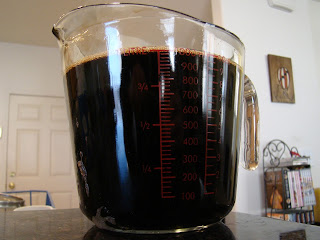For this summer's road trip beer, which traveled all the way back east across the country with me for work and family time for a month, I decided to go for a session-strength quick sour. The first examples of gose that I tried just a few years ago didn't excite me; the idea of a briny beer sounded disgusting, and that's how those first tastes read to my palate. My opinion of the style came up substantially, though, after a couple trips to Portland and its myriad kickass breweries. So, onward gose!
I've had plenty of success achieving a clean, lemony lactic sourness from sour worting with an uncrushed malt lacto starter. This time, though, I decided to combine its power with that of Goodbelly, highly touted by Milk the Funk for lacto souring. I found MTFers to generally recommend going with the mango version to minimize flavors contributed by the drink itself.
Trepidatious about ending up with an overly salty mess, I went conservative on the salt addition this time. Following the never-fail advice from the Mad Fermentationist, I did my best to forego the celery flavor of Mexican coriander in
favor of the Fruity Pebbles-like hit of the Indian version. Not having used either type in a beer before, however, I went light on that as well. For extra fun, I added some fresh nectarines (after freezing them) to a portion of the batch for a week before bottling.
So, how did the final beer(s) turn out? So well that I don't have a bottle remaining to do formal tasting notes. For those who liked sour beer, it went over very well: solidly tart without being tongue scraping with a robust tropical fruitiness (though not a new world overripe fruit character). It had a surprisingly full mouthfeel, probably from the high FG and mango in the Goodbelly, to which I also attribute that tropical fruit flavor. The salt and coriander were very subdued, so next time I'll definitely up those contributions.
I'll also consider sour worting for one day less; while the sourness wasn't overpowering, I think it might work even better here backing off it a touch. I'd be interested to see how Goodbelly does on its own; I dug the rounder, gentler lacto character this batch had over previous quick sours I've done with just malt starters. Another flavor of Goodbelly would be worth exploring, too; given how the mango carried over to the finished beer, one could definitely design a recipe to work with those residual characters.
While I didn't feel like downing bottle after bottle at a time of this, it was a welcome fresh flavor in the heat of a swampy summer.
No Witty Pun - Gose
Batch size: 5 gallons
Projected OG: 1.053
Projected SRM: 3.4
Projected IBU: 11.2
Boil time: 90 minutes
Brewhouse efficiency: 77%
Grains
48.8% - 5 lb Pilsner
48.8% - 5 lb White Wheat
2.4% - 4 oz Acidulated malt
Hops
.2 oz Galena (16%) (90 min)
Yeast
1.7 l Lacto starter
16 fl oz Goodbelly Mango probiotic drink
US-05
.5 tablet Whirlfloc (10 min)
1 tsp Yeast nutrient (10 min)
.5 oz Sea salt (0 min)
.5 oz Indian coriander seed (0 min)
3.5 lb Yellow nectarines, sliced & frozen (secondary)
Water (mash)
Profile: Reno
Lacto starter: 17 June 2017
1700 ml starter wort, 1 cup uncrushed malt, 1/2 tsp Lactic acid (88%), held at ~108F for 3 days.
Brewday: 20 June 2017
Mash: 13 qts @ 152F for 60 minutes
Sparge: 20 qts @ 190F
Pre-boil volume: 7 gallons
Pre-lacto SG: 10.8P (1.042)
Lacto fermentation: Brought to brief boil then chilled to 110F. Added 1/2 tsp Lactic acid (88%), Goodbelly at room temperature, and lacto starter. Covered wort surface with plastic wrap to reduce oxygen contact, held at ~103F for 3 days.
22 June 2017
Kettle was too full and the covering couldn’t keep a perfect seal. Sweet wort exhibits some fecal aromatics, but also includes a strong, full mango/peach aroma.
Transferred to boil kettle; boiled, hopped, chilled, and pitched US-05 as normal.
5.3 gallons to fermenter. Fermented in swamp cooler at 65F ambient.
28 June 2017: Allowed temp to rise 2F per day. Krauesen beginning to drop.
Bottled: 2 July 2017
FG: 1.015
ABV: 5.0%
Bottled 3 gallons with 3 oz table sugar.
Transferred remaining 2 gallons onto 2.5 lb yellow nectarines (frozen).
Nectarine Bottled: 9 July 2017
Bottled 1.75 gallons with 2 oz table sugar













